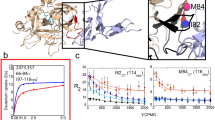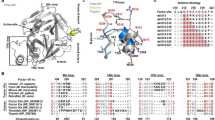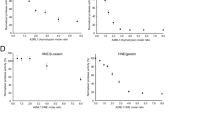Abstract
Antithrombin is a member of the serine proteinase inhibitor (serpin) family which contain a flexible reactive site loop that interacts with, and is cleaved by the target proteinase. In cleaved and latent serpins, the reactive site loop is inserted into a large central β–sheet in the same molecule, whereas in ovalbumin, a nonfunctional serpin, the reactive site loop is completely exposed and in an α–helical conformation. However, in neither conformation can the reactive site loop bind to target proteinases. Here we report the structure of an intact and cleaved human antithrombin complex. The intact reactive site loop is in a novel conformation that seems well suited for interaction with proteinases such as thrombin and blood coagulation factor Xa.
This is a preview of subscription content, access via your institution
Access options
Subscribe to this journal
Receive 12 print issues and online access
$189.00 per year
only $15.75 per issue
Buy this article
- Purchase on Springer Link
- Instant access to full article PDF
Prices may be subject to local taxes which are calculated during checkout
Similar content being viewed by others
References
Olson, S.T., & Björk, I. in Thrombin, structure and function (ed. Berliner, L. J.) 159–217 (Plenum, New York, 1992).
Downing, M.R., Bloom, J.W., & Mann, K.G. Comparison of the inhibition of thrombin by three plasma protease inhibitors. Biochemistry 17, 2649–2653 (1978).
Carrell, R.W., Evans, D.L.I. & Stein, P.E. Mobile reactive centre of serpins and the control of thrombosis. Nature 353, 576–578 (1991).
Hubbard, S.J., Campbell, S.F., & Thornton, J.M. Molecular recognition. Conformational analysis of limited proteolytic sites and serins proteinase inhibitors. J. molec. Biol. 220, 507–530 (1991).
Loebermann, H., Tokuoka, R., Deisenhofer, J. & Huber, R. Human α1-Proteinase inhibitor. Crystal structure analysis of two crystal modifications, molecular model and preliminary analysis of the implications for function. J. molec. Biol. 177, 531–556 (1984).
Mourey, L., et al. Antithrombin III: structural and functional aspects. Biochimie 72, 599–608 (1990).
Baumann, U., et al. Crystal structure of cleaved human α1-antichymotrypsin at 2.7 Å resolution and its comparison with other serpins. J. molec. Biol. 218, 595–606 (1991).
Mottonen, J., et al. Structural basis of latency in plasminogen activator inhibitor-1. Nature 355, 270–273 (1992).
Stein, P.E., et al. Crystal structure of ovalbumin as a model for the reactive centre of serpins. Nature 347, 99–102 (1990).
Jordan, R.E., Oosta, G.M., Gardner, W.T. & Rosenberg, R.D. The kinetics of hemostatic enzyme-antithrombin interactions in the presence of low molecular weight heparin J. biol. Chem. 255, 10081–10090 (1980).
Schreuder, H., et al. Crystallization and preliminary X-ray analysis of human antithrombin III. J. molec. Biol. 229, 249–250 (1993).
Schechter, I., & Berger, A. On the size of the active site in proteases. I. Papain. Biochem. biophys. Res. Commun. 27, 157–162 (1967).
Carrell, R.W., & Evans, D.L.I. Serpins: mobile conformations in a family of proteinase inhibitors. Curr. opin. Struct. Biol. 2, 438–446 (1992).
Tsunogae, Y. et al. Structure of the trypsin-binding domain of Bowman-Birk type protease inhibitor and its interaction with trypsin. J. Biochem. 100, 1637–1646 (1986).
Bode, W., Papamokos, E., Musil, D., Seemueller, U., & Fritz, H. Refined 1.2 Å crystal structure of the complex formed between subtilisin Carlsberg and the inhibitor eglin c. Molecular structure of eglin and its detailed interaction with subtilisin. EMBO J. 5, 813–818 (1986).
Gros, P., Betzel, Ch., Dauter, Z., Wilson, K.S., & Hol, W.G.J. Molecular dynamics refinement of a thermitase-eglin-c complex at 1.98 Å resolution and comparison of two crystal forms that differ in calcium content. J. molec. Biol. 210, 347–367 (1989).
Engh, R.A., Wright, H.T. & Huber, R. Modeling of the intact form of the α1-proteinase inhibitor. Protein Eng. 3, 469–477 (1990).
Bode, W., & Huber, R. Ligand binding: proteinase-protein inhibitor interactions. Curr. opin. Struct. Biol. 1, 45–52 (1991).
Mast, A.E., Enghild, J.J., & Salvesen, G. Conformation of the reactive site loop of α1-proteinase inhibitor probed by limited proteolysis. Biochemistry 31, 2720–2728 (1992).
Preissner, K.T. Self association of antithrombin III relates to multimer formation of thrombin-antithrombin complexes. Thromb. Haemostasis 69, 422–429 (1993).
Stein, P.E., Leslie, A.G.W., Finch, J.T., & Carrell, R.W. Crystal structure of uncleaved ovalbumin at 1.95 Å resolution. J. molec. Biol. 221, 941–959 (1991).
Bernstein, F.C. et al. The protein data bank: a computer-based archival file for macromolecular structures. J. molec. Biol. 112, 535–542 (1977).
Schreuder, H.A., et al. in Molecular Replacement, Proceedings of the CCP4 Study Weekend, 31 January - 1 February, 1992 (eds. Dodson, E. J, Gover, S and Wolf, W.) 106–115 (SERC Daresbury Laboratory, Warrington WA4 4AD, England, 1992).
Brünger, A.T. Solution of a Fab (26-10)/digitoxin complex by generalized molecular replacement. Acta Crystallogr. A47, 195–204 (1991).
Jones, T.A. Interactive computer graphics: FRODO. Meth. Enzym. 115, 157–171 (1985).
Jones, T.A. & Kjeldgaard, M. O version 5.8.1 (Dept. Molec. Biol., Univ. Uppsala, Sweden, 1992).
Mourey, L. et al. Crystal structure of cleaved bovine antithrombin III at 3.2 Å resolution. J. molec. Biol. 232, 223–241 (1993).
Bode, W. et al. The refined 1.9 Å crystal structure of human α-thrombin: interaction with D-Phe-Pro-Arg chloromethylketone and significance of the Tyr-Pro-Pro-Trp insertion segment. EMBO J. 8, 3467–3475 (1989).
Grootenhuis, P.D.J., & Boeckel, C.A.A. Constructing a molecular model of the interaction between antithrombin III and a potent heparin analogue. J. Am. chem. Soc. 113, 2743–2747 (1991).
Bode, W., Turk, D., & Karshikov, A. The refined 1.9-Å crystal structure of D-Phe-Pro-Arg chloromethylketone-inhibited human α-thrombin: Structure analysis, overall structure, electrostatic properties, detailed active-site geometry, and structure-function relationships. Prot. Sci. 1, 426–471 (1992).
Author information
Authors and Affiliations
Rights and permissions
About this article
Cite this article
Schreuder, H., de Boer, B., Dijkema, R. et al. The intact and cleaved human antithrombin III complex as a model for serpin–proteinase interactions. Nat Struct Mol Biol 1, 48–54 (1994). https://doi.org/10.1038/nsb0194-48
Received:
Accepted:
Issue Date:
DOI: https://doi.org/10.1038/nsb0194-48
This article is cited by
-
Identification and characterization of a novel variant in C-terminal region of Antithrombin (Ala427Thr) associated with type II AT deficiency leading to polymer formation
Journal of Thrombosis and Thrombolysis (2020)
-
ANISERP: a new serpin from the parasite Anisakis simplex
Parasites & Vectors (2015)
-
CLT1 targets angiogenic endothelium through CLIC1 and fibronectin
Angiogenesis (2012)
-
The ternary complex of antithrombin–anhydrothrombin–heparin reveals the basis of inhibitor specificity
Nature Structural & Molecular Biology (2004)



